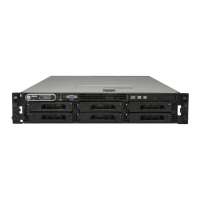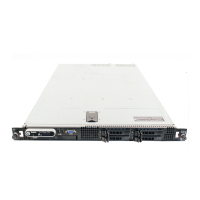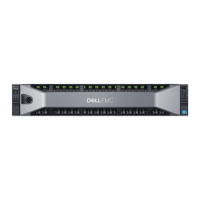6-4 Dell PowerEdge 4100/180 and 4100/200 Systems User’s Guide
SCSI Hard-Disk Drive Indicator Patterns
The three light-emitting diode (LED) indicators adjacent
to each of the six SCSI hard-disk drive bays provide
information on the status of the SCSI hard-disk drives.
The SCSI backplane firmware controls the drive online
and drive fault indicators, while the drive activity indica-
tor is usually controlled by the drive itself.
Table 6-1 lists the various drive indicator patterns. Differ-
ent patterns are displayed as drive events occur. For
example, in the event of a hard-disk drive failure, the
“drive failed” pattern appears. After the drive is selected
for removal, the “drive being prepared for removal” pat-
tern appears, followed by the “drive ready for removal”
pattern. After the replacement drive is installed, the
“drive being prepared for operation” pattern appears,
then the “drive online” pattern.
Removing a SCSI Hard-Disk Drive With the
System Running
Remove a SCSI hard-disk drive as follows:
1. Wait until the drive status indicators adjacent to
the drive bay signal that the drive may be
removed.
If the drive has been online, the three drive indica-
tors will flash sequentially as the drive is powered
down. When all three indicators stop flashing, the
drive is ready for removal.
2. Remove the hard-disk drive.
Follow the instructions in “Removing a SCSI Hard-
Disk Drive,” found earlier in this chapter.
Installing a SCSI Hard-Disk Drive With the
System Running
Install a SCSI hard-disk drive as follows:
1. Remove the drive or empty carrier from the drive
bay as described in the previous section.
2. Insert the “new” drive carrier into the bay.
Follow the instructions in “Installing a SCSI Hard-
Disk Drive,” found earlier in this chapter.
3. The drive online indicator will turn on.
Configuring the Boot Device
If you plan to boot the system from a hard-disk drive, the
drive must be attached to the primary (or boot) controller
or SCSI host adapter. The primary controller is deter-
mined according to the following general guidelines:
• If the PCI SCAN SEQUENCE category in the System
Setup program is set to EMBEDDED FIRST, the built-
in Ultra/Wide host adapter is the primary controller.
• If the PCI SCAN SEQUENCE category in the System
Setup program is set to SLOT DEVICES FIRST, the
system boots from a SCSI host adapter card in an
expansion slot. If two or more SCSI host adapter
cards are installed, the boot order is determined by
the expansion slot the card is installed in. In
descending order of precedence, the boot order is
PCI5, PCI4, PCI8, PCI7, PCI6.
Table 6-1. SCSI Hard-Disk Drive Indicator
Patterns
Condition Indicator Pattern
Identify drive All three drive status indicators
flash simultaneously.
Drive being pre-
pared for removal
The three drive status indicators
flash sequentially.
Drive ready for
insertion or
removal
All three indicators are off.
Drive being pre-
pared for operation
The drive online indicator is on.
The drive activity indicator may
flash briefly.
Drive bay empty All three indicators are off.
Drive predicted
failure
The drive online indicator turns
off. The drive fault indicator
blinks on briefly each second.
Drive failed The drive online indicator turns
off. The drive fault indicator
blinks off briefly each second.
Drive rebuilding The drive online indicator
blinks rapidly.
Drive online The online indicator is on.
